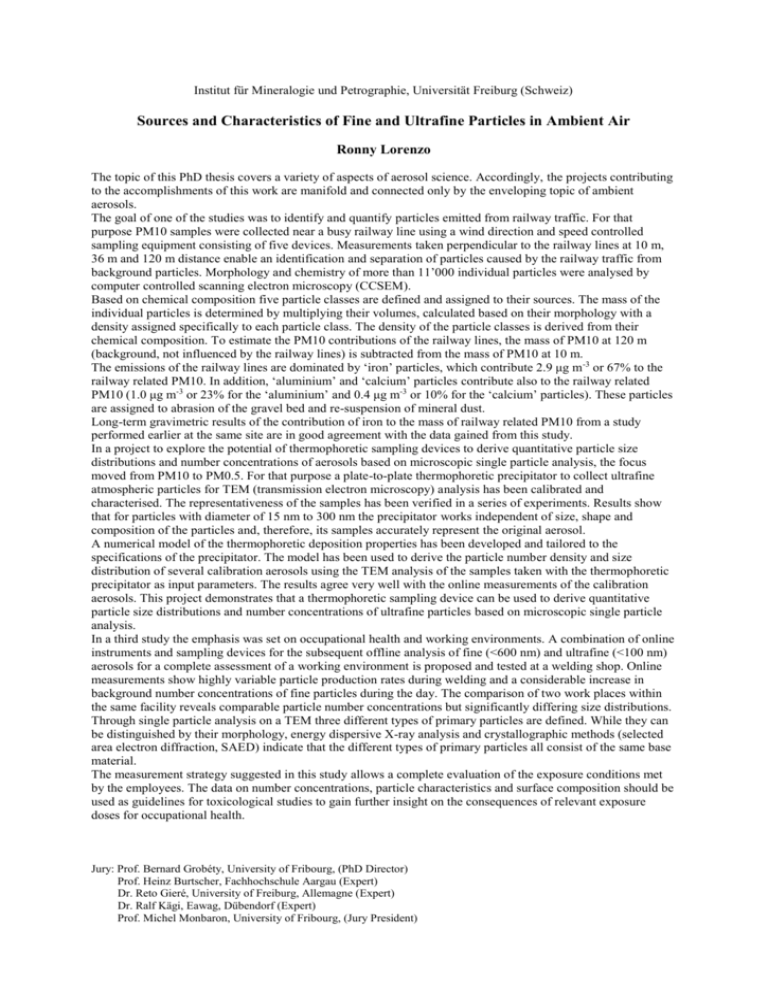Sources and Characteristics of Fine and Ultrafine Particles in
advertisement

Institut für Mineralogie und Petrographie, Universität Freiburg (Schweiz) Sources and Characteristics of Fine and Ultrafine Particles in Ambient Air Ronny Lorenzo The topic of this PhD thesis covers a variety of aspects of aerosol science. Accordingly, the projects contributing to the accomplishments of this work are manifold and connected only by the enveloping topic of ambient aerosols. The goal of one of the studies was to identify and quantify particles emitted from railway traffic. For that purpose PM10 samples were collected near a busy railway line using a wind direction and speed controlled sampling equipment consisting of five devices. Measurements taken perpendicular to the railway lines at 10 m, 36 m and 120 m distance enable an identification and separation of particles caused by the railway traffic from background particles. Morphology and chemistry of more than 11’000 individual particles were analysed by computer controlled scanning electron microscopy (CCSEM). Based on chemical composition five particle classes are defined and assigned to their sources. The mass of the individual particles is determined by multiplying their volumes, calculated based on their morphology with a density assigned specifically to each particle class. The density of the particle classes is derived from their chemical composition. To estimate the PM10 contributions of the railway lines, the mass of PM10 at 120 m (background, not influenced by the railway lines) is subtracted from the mass of PM10 at 10 m. The emissions of the railway lines are dominated by ‘iron’ particles, which contribute 2.9 μg m -3 or 67% to the railway related PM10. In addition, ‘aluminium’ and ‘calcium’ particles contribute also to the railway related PM10 (1.0 μg m-3 or 23% for the ‘aluminium’ and 0.4 μg m-3 or 10% for the ‘calcium’ particles). These particles are assigned to abrasion of the gravel bed and re-suspension of mineral dust. Long-term gravimetric results of the contribution of iron to the mass of railway related PM10 from a study performed earlier at the same site are in good agreement with the data gained from this study. In a project to explore the potential of thermophoretic sampling devices to derive quantitative particle size distributions and number concentrations of aerosols based on microscopic single particle analysis, the focus moved from PM10 to PM0.5. For that purpose a plate-to-plate thermophoretic precipitator to collect ultrafine atmospheric particles for TEM (transmission electron microscopy) analysis has been calibrated and characterised. The representativeness of the samples has been verified in a series of experiments. Results show that for particles with diameter of 15 nm to 300 nm the precipitator works independent of size, shape and composition of the particles and, therefore, its samples accurately represent the original aerosol. A numerical model of the thermophoretic deposition properties has been developed and tailored to the specifications of the precipitator. The model has been used to derive the particle number density and size distribution of several calibration aerosols using the TEM analysis of the samples taken with the thermophoretic precipitator as input parameters. The results agree very well with the online measurements of the calibration aerosols. This project demonstrates that a thermophoretic sampling device can be used to derive quantitative particle size distributions and number concentrations of ultrafine particles based on microscopic single particle analysis. In a third study the emphasis was set on occupational health and working environments. A combination of online instruments and sampling devices for the subsequent offline analysis of fine (<600 nm) and ultrafine (<100 nm) aerosols for a complete assessment of a working environment is proposed and tested at a welding shop. Online measurements show highly variable particle production rates during welding and a considerable increase in background number concentrations of fine particles during the day. The comparison of two work places within the same facility reveals comparable particle number concentrations but significantly differing size distributions. Through single particle analysis on a TEM three different types of primary particles are defined. While they can be distinguished by their morphology, energy dispersive X-ray analysis and crystallographic methods (selected area electron diffraction, SAED) indicate that the different types of primary particles all consist of the same base material. The measurement strategy suggested in this study allows a complete evaluation of the exposure conditions met by the employees. The data on number concentrations, particle characteristics and surface composition should be used as guidelines for toxicological studies to gain further insight on the consequences of relevant exposure doses for occupational health. Jury: Prof. Bernard Grobéty, University of Fribourg, (PhD Director) Prof. Heinz Burtscher, Fachhochschule Aargau (Expert) Dr. Reto Gieré, University of Freiburg, Allemagne (Expert) Dr. Ralf Kägi, Eawag, Dübendorf (Expert) Prof. Michel Monbaron, University of Fribourg, (Jury President)







